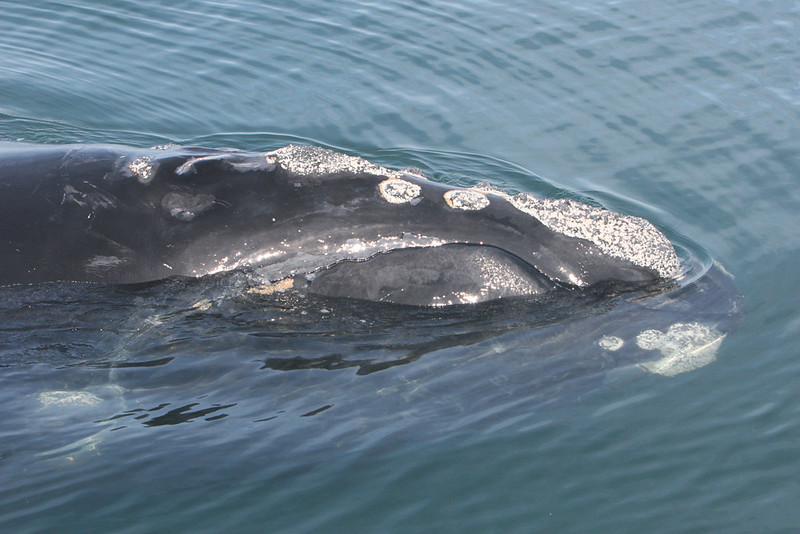TAKE ACTION to protect North Atlantic Right Whales and all marine life
The plight of the North Atlantic Right Whales has been at the forefront of marine conservation for several years. North Atlantic Right Whales can be found along the Atlantic Coast of the United States and Canada where they migrate between their feeding grounds in the North and breeding and calving grounds in the South. In 2017, an Unusual Mortality Event (UME) was declared as whales continued to die at a rapid rate. With less than 360 individuals remaining, this critically endangered whale has faced significant population decline due to human-induced threats, including fishing gear entanglements and vessel strike injuries.

Flipper entanglement
Entanglement in fishing gear is a significant cause of serious injury and mortality for right whales. The whale in this image has several fishing ropes wrapped around its flipper. Over time, the whale’s continued growth, combined with drag through the water and shifting, could cause these ropes to tighten, leading to bone damage, infection, and eventually death. In this image also note the broad, paddle-shaped black flipper, a characteristic of the species.
More information
Photo Credit (full credit required for use):
Florida Fish and Wildlife Conservation Commission, NOAA Research Permit # 932-1905/MA-009526
Entanglements
Fishing gear entanglements are one of the deadliest threats that North Atlantic Right Whales face. When a whale becomes entangled, the fishing gear can cut into the whale’s body causing deep lacerations and constriction injuries, leading to serious infections or even death. If the whale is able to shed the gear or it is removed by disentanglement teams, often the damage is already done. Entanglements are extremely stressful for the whales and can cause weakness and the inability to feed, reproduce, or swim.
Determining the origin of fishing gear involved in entanglements is challenging. Gear marking regulations have been implemented as a part of the Atlantic Large Whale Take Reduction Plan. Despite this management measure, the origin of a majority of entanglements is still unknown. However, some fisheries have been found to be responsible. The lobster pot/trap fishery has been a large focus of management modifications as past gear analyses confirmed their responsibility in some North Atlantic Right Whale entanglements. North Atlantic Right Whales have also had documented entanglements in some gillnet fisheries along the Atlantic Coast.
Researchers and activists alike have been advocating for the use of ropeless fishing gear in our commercial fisheries. Ropeless gear would eliminate the fishing ropes that hang in the water column attached to gear and surface buoys. Ropeless fishing gear not only decreases the likelihood of entanglements, but it also reduces the risk of lost gear as a result of strong storm surges. Multi-million dollar grants have been awarded to allow fishermen to participate in ropeless gear trial programs, however, most fishermen oppose the program and are not willing to participate.
As the number of new permits increase in many fisheries along the Atlantic Coast, more fishing gear is inevitably polluting our oceans and endangering marine life like the North Atlantic Right Whales. If we don’t act now, it will be too late.
Vessel Strike Injuries
North Atlantic Right Whales have fallen victim to vessel strike injuries time and time again. Over the years, several North Atlantic Right Whales have been seriously injured or killed as a result of blunt force trauma associated with vessel collisions. The migratory path of the North Atlantic Right Whales overlaps with maritime shipping lanes and their critical habitat is close to several major ports. Unfortunately, this leaves the whales especially vulnerable to collisions with vessels that can lead to serious injuries, including broken bones, internal injuries, lacerations, or even death. Vessels of any size can collide with and injure a whale. The faster a vessel is traveling the more likely it is to result in serious injury or death if a collision with a whale occurs.
Current vessel speed regulations require most vessels 65 feet in length or greater to reduce speeds to 10 knots while traveling through Seasonal Management Areas (SMAs) where North Atlantic Right Whales are known to frequent as they migrate along the coast. In 2022, NOAA proposed a new rule extending speed regulations to most vessels 35 feet in length or greater when traveling through SMAs. The final rule was expected in 2023. Unfortunately, it has not been implemented.
There is no greater time to advocate and take a strong stance to protect the last remaining North Atlantic Right Whales from vessel strike injuries.
Action Center




